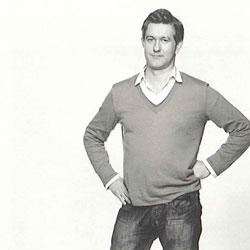Pedro Casqueiro
Pedro CasqueiroLisboa ¶ 1959
 |
|
| Créditos fotográficos / Photographic credits: Abílio Leitão |
He graduated at the Fine Arts School of Lisbon, and it was already in the very early 80s, when he was still a student, that he began exhibiting his first works. Rather than any theoretical or ideological standpoint, it is clear from his early work that he stresses a visual approach to painting. If references are found in his work, they're not clad in the guise of quotes or commentaries, but rather appear as pretexts for the development of dynamic displacements, multiplications and recompositions of visual elements. This is not a question of achieving a sort of synthesis model of great depuration and coldness, aloof from any kind of critical questioning. Quite the contrary, it's an inclination towards the use of several models at one time, within a logic of multiplication and complexification. ¶ At first, the employment of several graphic and composition solutions guided Casqueiro's painting to a true visual explosion, particularly because of the way he juxtaposes and contrasts colours and spaces. ¶ Between the late 80s and early 90s his painting became somewhat more jovial, with accurately designed surfaces, usually monochromatic backgrounds over which the customary juxtapositions take place, and in which the forms are organized or placed according to rhythmic patterns. ¶ From the mid-90s onwards, an architecture-like rigor is established, if not a geometrical simplification, in open disparity to the immediately previous mannerist flurry. And, more recently, Casqueiro has returned to a graphic and figurative referential linkage, sometimes close to comics but always according to his own personal rhythm of composition. ¶ As the most general trait of his oeuvre, one should highlight the permanent duplication of spaces, focused on a capacity to recombine two-dimensional spaces with three-dimensional suggestions or to crossbreed, as it were, abstract with figurative spaces. ¶ As in a virtual setting, space becomes a character itself, a character whose heartbeat is sensed according to the spectator's intensity of attention.
http://cvc.instituto-camoes.pt/biografias-en/pedro-casqueiro-1495.html#sigFreeId0d202bbd65


